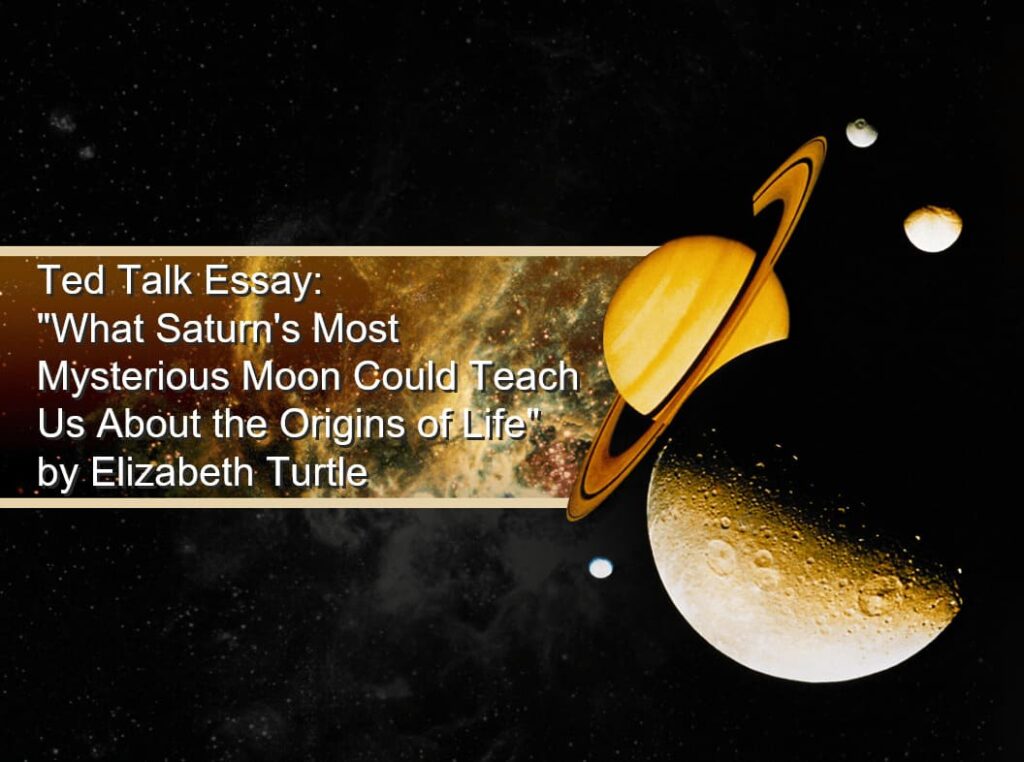Saturn is the second-largest planet in a solar system and has numerous moons orbiting around it. One of those space bodies is Titan. In this Ted Talk essay on “What Saturn’s Most Mysterious Moon Could Teach Us About the Origins of Life” by Elizabeth Turtle, the author expands human knowledge on Titan, being a moon.
Uniqueness of Titan
Titan is as unique as Earth, and future planned explorations would give scientists a greater understanding of the moon and whether it can support life. It is the only known place in the solar system, other than Earth, to have liquid bodies, such as oceans, seas, and lakes on its surface and a nitrogen-rich atmosphere (“Titan” par. 2). The liquid cycle on Titan is similar to the Earth’s water cycle, where there is evaporation, condensation, and rain from the clouds. In this case, Turtle notes that developments are underway to create a state-of-the-art spacecraft capable of roving and collecting specimens from the moon for analysis to understand the makeup of its organic compounds and whether there are existing life forms on Titan (3:20-5:40). Given some similarities that Titan and Earth share together, an exploration of the moon may help scientists to gain a greater understanding of the origins of life on Earth during its infancy stage, as it is believed that Titan is in its evolutionary infancy. This aspect is fascinating since the expedition may give stronger evidence and credence to theories about life forms evolving.

Knowledge of Universe
This connects particularly to musings about the universe, theories on how people come to be, and what human life purpose is if they are nothing but a speck in the wider universe. Varying theories have existed about how life comes to be, from evolution to creation. Peters et al. attempt to linkup space explorations and evolution theory to theology theories and note that astrobiology, the infiniteness of the universe, and the possibility of other sentient creatures existing somewhere else in themselves, meaning a divinity (10). This aspect is because it does not only spur a human desire to gain more knowledge as to whether other life forms exist out there but also stirs a human spirit to marvel in wonder at how big and complex the universe is. Titan is so much like Earth, yet so different. Unlike Earth, it has underground water bodies, while the upside lakes and seas are primarily made of methane, and the atmosphere is made of nitrogen and methane gas (“Titan” par. 2). This is like the antithesis of Earth, and considering its distance further from the sun, any life forms capable of surviving in the environment would be so much different from life forms on Earth.
Future Directions
Such knowledge may be applied in philosophical discussions about the beginnings of life, the dominance of humans, and the capability to colonize far off habitable planets. So far, people have not met any other known life forms that have ventured to explore the solar system. The level of artificial intelligence required for deep space robotics systems to function autonomously has significantly grown in recent decades (Gao and Chien 6). This feature means that explorations will get more meaningful data. In turn, there is a possibility of the spacecraft travel and sending messages over billions of kilometers and remaining functional for so long in a foreign environment.
Conclusion
In conclusion, planned explorations would give humans a greater understanding of Titan and life forms in their infancy. The video has made people think of my place and purpose within the wider universe and the varying ideas on how they come to be. It has also provided material for any future philosophical discussions.
Works Cited
Gao, Yang, and Steve Chien. “Review on Space Robotics: Towards Top-Level Science Through Space Exploration. Science Robotics, vol. 2, no. 7, 2017, pp. 1 – 12, doi: 10.1126/scirobotics.aan5074.
Peters, Ted, et al. “Introducing Astrotheology.” Astrotheology: Science and Theology Meet Extraterrestrial Life, Wipf and Stock Publishers, 2018, pp. 3-26.
“Titan.” Nasa Solar System Exploration, 2020, solarsystem.nasa.gov/moons/saturn-moons/titan/in-depth/.
Turtle, Elizabeth. “What Saturn’s Most Mysterious Moon Could Teach Us About the Origins of Life,” TED, 2020, www.ted.com/talks/elizabeth_zibi_turtle_what_saturn_s_most_mysterious_moon_could_teach_us_about_the_origins_of_life.


